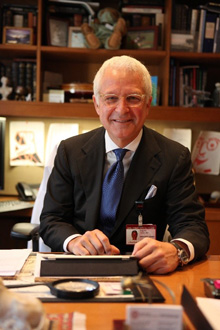
It’s a tremendous honor, and a great responsibility, to be someone’s neurosurgeon. My patients come to me with brain tumors, cerebrovascular disorders, and other neurosurgical conditions, and they entrust me not only with their brains but also with their minds, their senses, and even their emotions. Helping patients understand how a brain condition can affect all of those is a significant part of my job.
We understand more now today than ever before that what were once thought of separately as “brain” and “mind” are closely connected, if not actually one and the same. For a long time, we’ve thought of some types of brain disorders as physical ailments and other types as mental or emotional conditions. The more we learn about the brain, however, the more we understand that that’s not necessarily the case. A disruption in the brain, whether it be from a tumor, stroke, or trauma — or from the surgery to repair them — can cause physical changes, emotional changes, and cognitive changes. We may experience those changes differently, but they all have their origins in the same disruption.
Additionally, we are learning more every day about how slender the difference is (if there is a difference at all) between the physical and emotional results of a brain injury. Dr. Daniel P. Perl, a neuropathologist at the Uniformed Services University of the Health Sciences in Bethesda, Maryland, recently published fascinating results about what happens in the brain after a blast injury – this is the first time we’ve seen evidence that an individual who was somewhere near an explosion can suffer a significant physical brain injury even if other injuries don’t seem serious. This raises that possibility that what was called “shell shock” in World War I, “combat fatigue” in World War II, and “post-traumatic stress disorder” today may all be the result of a physiological brain injury caused by blast waves emanating from an explosion. If that does indeed turn out to be the case, it could completely change the treatment approach for our wounded warriors.
Fortunately, we’ve also learned a lot about neuroplasticity, the brain’s ability to heal and rewire itself. Where we once thought that brain cells that were damaged or destroyed were gone forever, with their functions along with them, we now know that the brain has a fascinating capacity for renewal. That repair and renewal can also go on for far longer than the 30 days we once believed to be the window for recovery, and it involves not just neurological surgery but a range of health care professionals.
That’s one of the reasons why the neurosurgeon’s role has changed over the years. There’s been a paradigm shift in how we must educate and guide our patients through the maze of brain therapies and the complexity of our health care system. I believe my role as a neurosurgeon goes far beyond my skill in the OR. It’s about my relationship with my patients and doing everything in my power to make their lives as productive as possible. Getting them back to their daily lives, and embracing whatever changes they experience, is what keeps me energized and excited about the work I do.
More about Dr. Perl's study
More about Traumatic Brain Injury